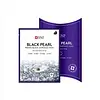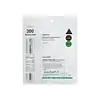What's inside
What's inside
 Key Ingredients
Key Ingredients

 Benefits
Benefits

 Concerns
Concerns

 Ingredients Side-by-side
Ingredients Side-by-side

Water
Skin ConditioningGlycerin
HumectantNiacinamide
SmoothingPearl Extract
AntioxidantGlycine Soja Seed Extract
Skin ConditioningSesamum Indicum Seed Extract
Skin ConditioningOryza Sativa Extract
AbsorbentSalvia Hispanica Seed Extract
EmollientRubus Fruticosus Fruit Extract
AstringentSolanum Melongena Fruit Extract
Skin ConditioningVaccinium Angustifolium Fruit Extract
Skin ProtectingRibes Nigrum Leaf Extract
PerfumingEuterpe Oleracea Fruit Extract
Hamamelis Virginiana Leaf Extract
Skin ConditioningChamomilla Recutita Flower Extract
MaskingCentella Asiatica Extract
CleansingCamellia Sinensis Leaf Extract
AntimicrobialAloe Barbadensis Leaf Extract
EmollientCeramide NP
Skin ConditioningSodium Hyaluronate
HumectantBetaine
HumectantButylene Glycol
HumectantPolysorbate 80
EmulsifyingHydroxyethylcellulose
Emulsion StabilisingCarbomer
Emulsion StabilisingTriethanolamine
BufferingDisodium EDTA
Alcohol
AntimicrobialEthyl Hexanediol
Solvent1,2-Hexanediol
Skin ConditioningPhenoxyethanol
PreservativeEthylhexylglycerin
Skin ConditioningCaprylyl Glycol
EmollientParfum
MaskingWater, Glycerin, Niacinamide, Pearl Extract, Glycine Soja Seed Extract, Sesamum Indicum Seed Extract, Oryza Sativa Extract, Salvia Hispanica Seed Extract, Rubus Fruticosus Fruit Extract, Solanum Melongena Fruit Extract, Vaccinium Angustifolium Fruit Extract, Ribes Nigrum Leaf Extract, Euterpe Oleracea Fruit Extract, Hamamelis Virginiana Leaf Extract, Chamomilla Recutita Flower Extract, Centella Asiatica Extract, Camellia Sinensis Leaf Extract, Aloe Barbadensis Leaf Extract, Ceramide NP, Sodium Hyaluronate, Betaine, Butylene Glycol, Polysorbate 80, Hydroxyethylcellulose, Carbomer, Triethanolamine, Disodium EDTA, Alcohol, Ethyl Hexanediol, 1,2-Hexanediol, Phenoxyethanol, Ethylhexylglycerin, Caprylyl Glycol, Parfum
Water
Skin ConditioningDipropylene Glycol
HumectantGlycerin
HumectantNiacinamide
SmoothingButylene Glycol
HumectantMacadamia Ternifolia Seed Oil
Emollient1,2-Hexanediol
Skin ConditioningEthylhexyl Palmitate
EmollientSilica
AbrasiveSodium Acrylate/Sodium Acryloyldimethyl Taurate Copolymer
Emulsion StabilisingPolyisobutene
Glycereth-26
HumectantEthylhexylglycerin
Skin ConditioningCaprylyl Glycol
EmollientAdenosine
Skin ConditioningSodium Polyacrylate
AbsorbentCentella Asiatica Extract
CleansingSodium Hyaluronate
HumectantCaprylyl/Capryl Glucoside
CleansingSorbitan Oleate
EmulsifyingXanthan Gum
EmulsifyingPropolis Extract
Skin ConditioningAsiaticoside
AntioxidantMadecassoside
AntioxidantMadecassic Acid
Skin ConditioningAsiatic Acid
Skin ConditioningGlycine
BufferingSerine
MaskingGlutamic Acid
HumectantAspartic Acid
MaskingLeucine
Skin ConditioningAlanine
MaskingLysine
Skin ConditioningArginine
MaskingTyrosine
MaskingPhenylalanine
MaskingThreonine
Proline
Skin ConditioningValine
MaskingIsoleucine
Skin ConditioningHistidine
HumectantMethionine
Skin ConditioningCysteine
AntioxidantIsopentyldiol
HumectantBetaine
HumectantHydroxyacetophenone
AntioxidantHydroxyethyl Acrylate/Sodium Acryloyldimethyl Taurate Copolymer
Emulsion StabilisingAmmonium Acryloyldimethyltaurate/Vp Copolymer
Olea Europaea Fruit Oil
MaskingButyrospermum Parkii Butter
Skin ConditioningCaprylic/Capric Triglyceride
MaskingHydrogenated Lecithin
EmulsifyingSqualane
EmollientDisodium EDTA
Sorbitan Isostearate
EmulsifyingCeramide NP
Skin ConditioningCholesterol
EmollientPhytosphingosine
Skin ConditioningOleic Acid
EmollientStearic Acid
CleansingHydrolyzed Collagen
EmollientTocopherol
AntioxidantBrassica Campestris Sterols
EmollientWater, Dipropylene Glycol, Glycerin, Niacinamide, Butylene Glycol, Macadamia Ternifolia Seed Oil, 1,2-Hexanediol, Ethylhexyl Palmitate, Silica, Sodium Acrylate/Sodium Acryloyldimethyl Taurate Copolymer, Polyisobutene, Glycereth-26, Ethylhexylglycerin, Caprylyl Glycol, Adenosine, Sodium Polyacrylate, Centella Asiatica Extract, Sodium Hyaluronate, Caprylyl/Capryl Glucoside, Sorbitan Oleate, Xanthan Gum, Propolis Extract, Asiaticoside, Madecassoside, Madecassic Acid, Asiatic Acid, Glycine, Serine, Glutamic Acid, Aspartic Acid, Leucine, Alanine, Lysine, Arginine, Tyrosine, Phenylalanine, Threonine, Proline, Valine, Isoleucine, Histidine, Methionine, Cysteine, Isopentyldiol, Betaine, Hydroxyacetophenone, Hydroxyethyl Acrylate/Sodium Acryloyldimethyl Taurate Copolymer, Ammonium Acryloyldimethyltaurate/Vp Copolymer, Olea Europaea Fruit Oil, Butyrospermum Parkii Butter, Caprylic/Capric Triglyceride, Hydrogenated Lecithin, Squalane, Disodium EDTA, Sorbitan Isostearate, Ceramide NP, Cholesterol, Phytosphingosine, Oleic Acid, Stearic Acid, Hydrolyzed Collagen, Tocopherol, Brassica Campestris Sterols
Ingredients Explained
These ingredients are found in both products.
Ingredients higher up in an ingredient list are typically present in a larger amount.
1,2-Hexanediol is a synthetic liquid and another multi-functional powerhouse.
It is a:
- Humectant, drawing moisture into the skin
- Emollient, helping to soften skin
- Solvent, dispersing and stabilizing formulas
- Preservative booster, enhancing the antimicrobial activity of other preservatives
Betaine is a common humectant (a substance that promotes retention of moisture). It's known to be gentle on the skin and can help balance hydration.
This ingredient is best for improving hydration and soothing irritated skin. Studies also show it helps even out skin tone.
Fun fact: Betaine is naturally created in the skin and body. The kind found within cosmetic products can be either plant-derived or synthetic.
Another name for betaine is trimethylglycine.
Learn more about BetaineButylene Glycol (or BG) is used within cosmetic products for a few different reasons:
Overall, Butylene Glycol is a safe and well-rounded ingredient that works well with other ingredients.
Though this ingredient works well with most skin types, some people with sensitive skin may experience a reaction such as allergic rashes, closed comedones, or itchiness.
Learn more about Butylene GlycolCaprylyl Glycol is a humectant and emollient, meaning it attracts and preserves moisture.
It is a common ingredient in many products, especially those designed to hydrate skin. The primary benefits are retaining moisture, skin softening, and promoting a healthy skin barrier.
Though Caprylyl Glycol is an alcohol derived from fatty acids, it is not the kind that can dry out skin.
This ingredient is also used as a preservative to extend the life of products. It has slight antimicrobial properties.
Learn more about Caprylyl GlycolCentella Asiatica Extract (Centella) is derived from an herb native to Southeast Asia. It is famous for its anti-inflammatory and soothing properties.
Centella is rich in antioxidants and amino acids, such as Madecassic Acid and Asiaticoside.
Studies show the compounds in centella help with:
The combination of all these properties makes centella effective at soothing, hydrating, and protecting the skin.
Other great components of centella include Vitamin A, vitamin C, several B vitamins, and Asiatic Acid.
Fun fact: Centella has been used as a medicine and in food for many centuries. As a medicine, it is used to treat burns, scratches, and wounds.
Learn more about Centella Asiatica ExtractCeramide NP is a type of ceramide and formally known as ceramide 3.
Ceramides are intercellular lipids naturally found in our skin that bonds dead skin cells together to create a barrier. They are known for their ability to hold water and thus are a great ingredient for dry skin.
Ceramides are an important building block for our skin barrier. A stronger barrier helps the skin look more firm and hydrated. By bolstering the skin ceramides act as a barrier against irritating ingredients. This can help with inflammation as well.
If you would like to eat ceramides, sweet potatoes contain a small amount.
Read more about other common types of ceramides here:
Ceramide AP
Ceramide EOP
Disodium EDTA plays a role in making products more stable by aiding other preservatives.
It is a chelating agent, meaning it neutralizes metal ions that may be found in a product.
Disodium EDTA is a salt of edetic acid and is found to be safe in cosmetic ingredients.
Learn more about Disodium EDTAEthylhexylglycerin (we can't pronounce this either) is commonly used as a preservative and skin softener. It is derived from glyceryl.
You might see Ethylhexylglycerin often paired with other preservatives such as phenoxyethanol. Ethylhexylglycerin has been found to increase the effectiveness of these other preservatives.
Glycerin is already naturally found in your skin. It helps moisturize and protect your skin.
A study from 2016 found glycerin to be more effective as a humectant than AHAs and hyaluronic acid.
As a humectant, it helps the skin stay hydrated by pulling moisture to your skin. The low molecular weight of glycerin allows it to pull moisture into the deeper layers of your skin.
Hydrated skin improves your skin barrier; Your skin barrier helps protect against irritants and bacteria.
Glycerin has also been found to have antimicrobial and antiviral properties. Due to these properties, glycerin is often used in wound and burn treatments.
In cosmetics, glycerin is usually derived from plants such as soybean or palm. However, it can also be sourced from animals, such as tallow or animal fat.
This ingredient is organic, colorless, odorless, and non-toxic.
Glycerin is the name for this ingredient in American English. British English uses Glycerol/Glycerine.
Learn more about GlycerinNiacinamide is a multitasking form of vitamin B3 that strengthens the skin barrier, reduces pores and dark spots, regulates oil, and improves signs of aging.
And the best part? It's gentle and well-tolerated by most skin types, including sensitive and reactive skin.
You might have heard of "niacin flush", or the reddening of skin that causes itchiness. Niacinamide has not been found to cause this.
In very rare cases, some individuals may not be able to tolerate niacinamide at all or experience an allergic reaction to it.
If you are experiencing flaking, irritation, and dryness with this ingredient, be sure to double check all your products as this ingredient can be found in all categories of skincare.
When incorporating niacinamide into your routine, look out for concentration amounts. Typically, 5% niacinamide provides benefits such as fading dark spots. However, if you have sensitive skin, it is better to begin with a smaller concentration.
When you apply niacinamide to your skin, your body converts it into nicotinamide adenine dinucleotide (NAD). NAD is an essential coenzyme that is already found in your cells as "fuel" and powers countless biological processes.
In your skin, NAD helps repair cell damage, produce new healthy cells, support collagen production, strengthen the skin barrier, and fight environmental stressors (like UV and pollution).
Our natural NAD levels start to decline with age, leading to slower skin repair, visible aging, and a weaker skin barrier. By providing your skin niacinamide, you're recharging your skin's NAD levels. This leads to stronger, healthier, and younger looking skin.
Another name for vitamin B3 is nicotinamide. This vitamin is water-soluble and our bodies don't store it. We obtain Vitamin B3 from either food or skincare. Meat, fish, wheat, yeast, and leafy greens contain vitamin B3.
The type of niacinamide used in skincare is synthetically created.
Learn more about NiacinamideSodium Hyaluronate is hyaluronic acid's salt form. It is commonly derived from the sodium salt of hyaluronic acid.
Like hyaluronic acid, it is great at holding water and acts as a humectant. This makes it a great skin hydrating ingredient.
Sodium Hyaluronate is naturally occurring in our bodies and is mostly found in eye fluid and joints.
These are some other common types of Hyaluronic Acid:
Learn more about Sodium HyaluronateWater. It's the most common cosmetic ingredient of all. You'll usually see it at the top of ingredient lists, meaning that it makes up the largest part of the product.
So why is it so popular? Water most often acts as a solvent - this means that it helps dissolve other ingredients into the formulation.
You'll also recognize water as that liquid we all need to stay alive. If you see this, drink a glass of water. Stay hydrated!
Learn more about Water